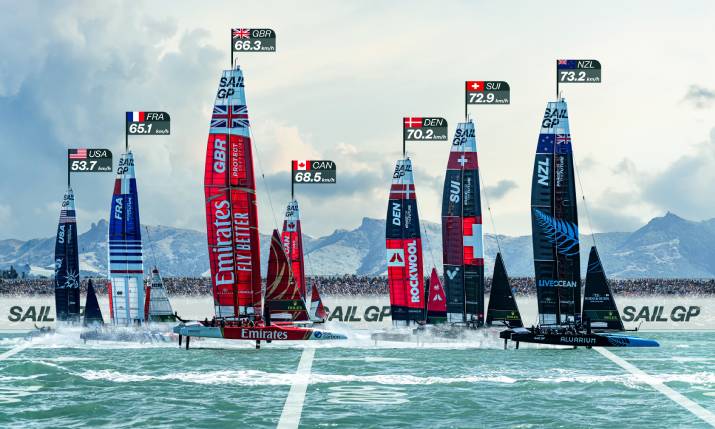Stage 1 of the 106th Giro d’Italia ©kramon
With the Giro d’Italia in full swing, SVG Europe speaks to the team behind EMG’s production of the three-week Grand Tour, to explore the logistics and planning that goes into such a long and challenging event.
Davide Furlan and Bruno Coudizer are overall project managers. Furlan’s responsibilities include the co-ordination and technical control of the workflow between the various media and the TV compound, the satellite booking for all contribution feeds and the management of all suppliers and related budget costs.
Coudizer manages and co-ordinates all the moving parts, including the crew specialised in cycling production, the motorcycle crew and the Cineflex operators in the helicopters. Furthermore, thanks to his experience in sports production, Coudizer is this year taking on the role of assistant director.
The EMG Italy production team deployed for the Giro d’Italia is completed by Matteo Fragni, unit manager on site, Mario Lovallo, producer on site, and Isabella Leoni, together with Valentina D’Alia and Nicolò Selvestrel and Salvatore Amato in support, who manage the booking of accommodation at each stage.
“This year,” says Furlan, “the television production of the Giro d’Italia created by EMG is international; it’s led by EMG Italy in collaboration with EMG Belgium and EMG Connectivity of France, and with the important addition of the graphics and timing divisions of Boost Graphics and Microplus.”
EMG provides personnel specialised in filming on board motorcycles and in the radio frequency connection sector, as well as those who manage the aerial links for filming and all service communications and connectivity.
“The entire budget and all service providers are managed in Italy, including helicopters which are an important workflow resource, frequency concessions and their co-ordination for all broadcasters, the logistics of the 143 people involved with planes, cars, vans, buses, trains and above all hotel rooms, as well as ground shooting and general co-ordination during all the movements between stages,” he adds.
“My job is to help co-ordinate production,” Fragni intervenes. “We started with pre-production in the months preceding the event, which involved organising the teams, all the logistics and the technology involved.”
“In addition to the Giro d’Italia,” says Lovallo, “I am busy following the other cycling events in Italy that have been taking place since March, such as Strade Bianche, the Tirreno-Adriatico and the Giro di Sicilia.
“I mainly deal with the co-ordination of the television media present at the TV compound, including those of RAI and the integrated broadcasters. We arrive in the evening in each city hosting the stage and we set up the parking lot from scratch where all the television media operate. With the Giro d’Italia we need to be ready to react to the inevitable unforeseen events of all kinds at each stage, so being present to always guarantee the best solution for everyone is fundamental.”
Producer Mario Lovallo and unit manager Matteo Fragni outside the Orion 209 OB
The EMG team is made up of those on the ground who take care of filming, including the camera operators assigned to the 4-5 cameras placed before the finish line and the other 7-8, placed after the finish, depending on the stages.
In addition, staff dedicated to camera controls on board the main gallery truck and those devoted to audio recordings are on site.
The control room of the Orion 209 OB has a set-up of 14 cameras on the ground in the finish area, and it is Belgian director Gunther Herregodts who decides which supports to prepare and where, after the morning inspection at each stage.
More on Giro d’Italia:
Most of the time the cameras are placed on typical mounts or hi-lo’s at the side of the track, identical to those used behind football goals; these mounts elevate the operator and camera above the heads of the fans.
At some arrivals, shoulder camera shots are used to create impressive images and cameras are also set up on Magnum Duo mini mobile cranes, where the operator, remaining seated together with the camera, can choose the shooting height using a remote control that operates a hydraulic column. This allows for a higher shooting point above the heads of the public gathering to see the arrivals and above the umbrellas that have often been out thanks to rainy weather this May.
Daily live coverage
The Giro d’Italia is made up of 29 production days with 21 live race stages during which the whole team starts in the morning with a meeting around 8:30 and finishes around 19:30. They produce about eight hours of live coverage every day, before leaving for the next stage.
The work continues for at least an hour after the arrival of the cyclists to capture the award ceremonies where jerseys are awarded to the various winners.
In addition, EMG also produces a newsfeed on site with three-minute highlights edited for distribution dedicated to international takers. The contents are distributed via satellite and also via streaming, through a dedicated portal.
The TV compound
Around 20 trucks, including those from EMG operations and support, are parked in the 2,000sqm TV compound each day to make the production of the Giro possible.
Content from other broadcasters, such as Discovery, is also packaged here, and RAI also operates from the compound, following the event with a dozen of its own mobile vehicles to deliver full coverage of the race.
It is essential that everything works perfectly in the compound, that the spaces are adequate, everyone has electricity, that the vehicles in charge of distributing the SNG satellite signals can see the south and there are no blocks of flats or impediments in the line of sight between the ground station and the satellite connection. Preliminary preparation also involves having the necessary information available for all to broadcast the signal to the various takers.
The distribution of the signals starts months before, given that it is complex set up. The main satellite truck vehicle receives four signals – one from the departure links, two from the intermediate relay stations which are equipped with two other SNG vans, and a signal transmitted by an SNG mobile vehicle placed at the arrival – in addition to distributing them.
There are also some special additions such as for Discovery which, from the stage in Viareggio to the stage in Rome, broadcasts live commentary via satellite from a commentator following the cyclists aboard a motorbike using their own video camera and microphone, interacting with the various studios of Eurosport France and England along the way.
Switzerland’s TSI is also present at the Giro with a commentary station, flanked by another seven broadcasters located in a two-storey mobile vehicle supplied by RCS and placed near the finish line.
Ready for anything
“We must be ready for anything,” concludes Fragni, “sometimes even with drastic interventions. In fact, every morning we find ourselves working in new places and it often happens that we have to pick up a chainsaw to cut tree branches that block the view.
“Several times we have also had to temporarily move road signs installed after the inspections made months before, orienting them differently to prevent them from appearing in the camera shots.”
“Another fascinating aspect that makes us proud of this incredible travelling production is the magic that happens every morning when we arrive in a dedicated and completely empty area of a new city,” he continues.
“Here, in just two hours and out of nowhere, the TV compound rises – this incredible mass, isolated by barriers, which collects antenna cables, technical structures, crowded with mobile control units and cranes, radio links, SNG mobile vehicles, shooting studios, UPS power supplies, and the trucks of the broadcasters.
“The same magic happens in the evening where in just two hours everything disappears and the city returns to what it was, completely empty. After having left everything free and clean, we are already on our way to the next stage, where everything will start again.”


